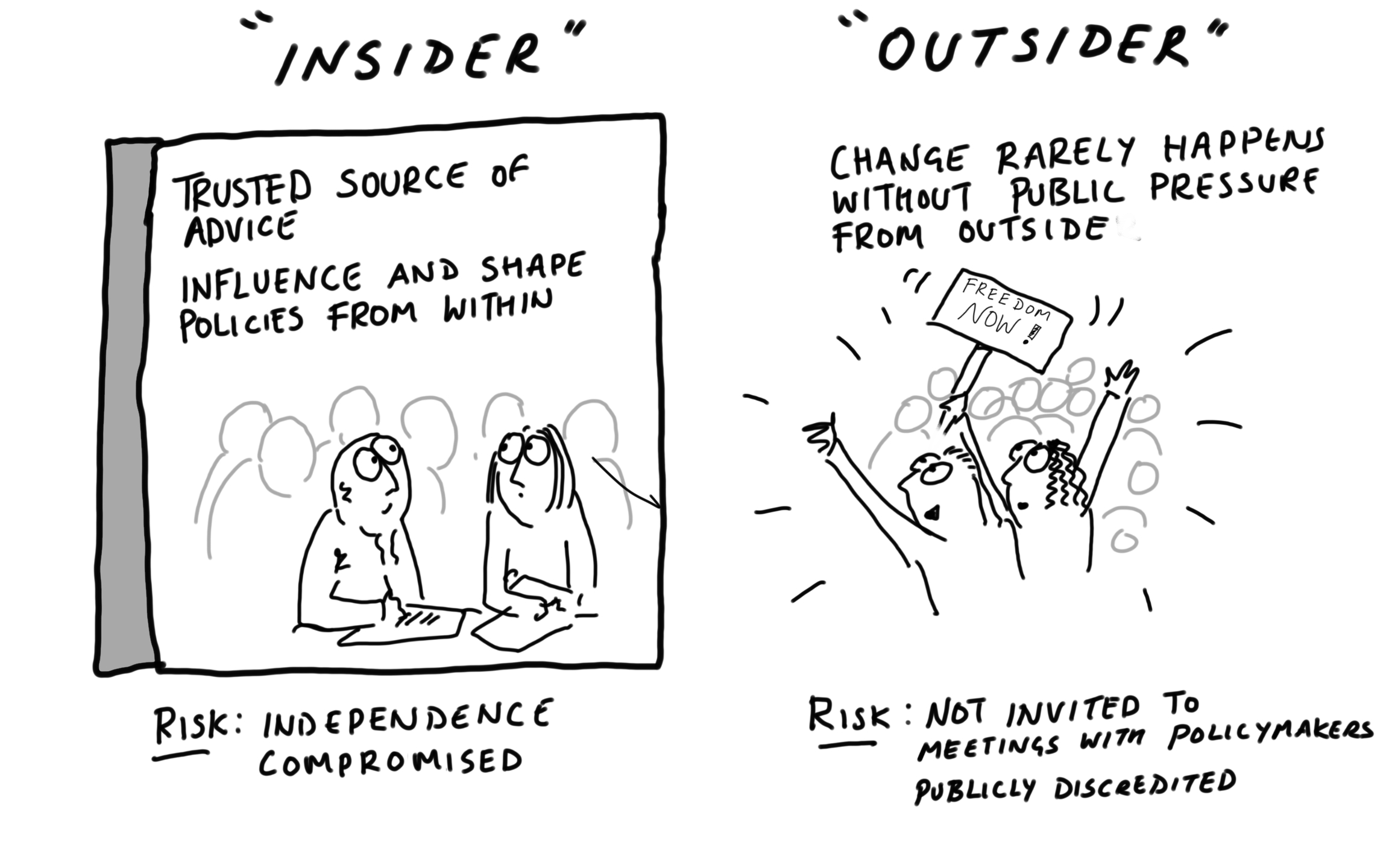Section 05: Identifying tactics and approaches
5.1: Identifying your overall tactics and approach
You have clarified your advocacy goal.
You have analysed the external context for your advocacy: the threats and opportunities in relation to your advocacy goal, the policy and political context, who has the power to bring about the change you are seeking, and who has a stake or interest in this change.
You have reflected on the internal context within your own organisation (expertise, experience, mission etc).
Now you need to think about tactics – and the approach you will take – based on all of the above analysis. What is your theory of change? In other words, what is your theory for how the advocacy goal can be achieved and for how your organisation can contribute to its achievement?
"Strategy requires thought, tactics require observation." Max Euwe (chess champion)
The approach you take will depend on:
The external context: how political change comes about in your context, what approaches are likely to have the most impact on those you are seeking to influence.
The internal context: your organisation’s capacity, expertise, and mission, plus the expectations of your stakeholders and the kind of approaches they feel comfortable with.
The type of change you are seeking:radical change may require tactics such as public campaigning whereas small incremental changes may be secured through more discreet direct engagement with those who have the power to make these changes.
5.2: 'Insider' and 'outsider' approaches
`Insider’ Approach
This refers to private influencing work and direct engagement with powerful actors behind closed doors. The engagement is often with policymakers but may also be with community leaders or religious leaders. It tends to involve constructive dialogue and relationship-building. With this approach, the emphasis is on research and analysis which is shared with the powerful actors to influence them directly and build your credibility. It usually involves gentle persuasion. It is more of a collaborative approach in contrast to the more adversarial 'outsider' approach.
Sometimes, the `insider’ approach involves working with allies inside the system and supporting them to better influence their superiors.
`Outsider’ Approach
Advocacy conducted outside the corridors of power - for example a protest that is physically outside a government building, not a meeting with government inside the building. It is an outside approach in a metaphorical sense too because the advocacy is being undertaken in public, not through private engagement.
This approach tends to involve public campaigning and mobilisation of citizens, protests, stunts, or media work. It will often be distinguished by a simple and direct message (eg. `Bring back our girls’ or `drop the debt’). It may harness people’s anger and passion by shaming policymakers and exposing wrongs - but it doesn’t have to be confrontational. Sometimes a public campaign can have quite a soft message to attract a diverse range of supporters (eg. `Peace Now’, `Poverty Over’ etc).
The approach you take may depend on the kind of change you are seeking to secure through advocacy. The `insider’ approach may be sufficient to secure smaller, incremental reforms whereas an`outsider’ approach may be required for bigger, more radical changes which may not be achieved without public pressure.
Further resources: Case-studies of successful advocacy strategies
Ban Landmines campaign - example of a successful advocacy initiative that combined `insider’ advocacy with `outsider’ tactics.
How Big is Yours campaign to stop under-sized fishing in Turkey – example of a successful 'outsider' campaign
5.3 Benefits and risks of 'insider' and 'outsider' approaches
| Approach | Benefits | Risks |
|---|---|---|
"Insider" | You can become a trusted source of advice and can access important information about policy processes. You may be able to influence and shape policies directly. | Possibility of being co-opted by those you are seeking to influence. You may find your independence is compromised |
"Outsider" | Change rarely happens without public pressure from outside. | You may not be invited to meetings with policymakers and you may find you are publicly discredited by them. |
A combination of the two approaches can be very effective – with different organisations within the same coalition taking on different roles, for example. Alternatively you could start with the insider approach and then switch to a more public `outsider’ approach if the insider approach isn’t working.
Just make sure you discuss with your colleagues and partners what overall approach you will take before you start planning your advocacy activities.
5.4 Advocacy approaches to consider in restrictive contexts
In a growing number of countries, governments have become suspicious of NGOs’ advocacy and have tried to restrict it. In spite of this, it is nearly always possible to do something to try to secure the change you seek – however restricted the context. In these contexts, make sure you:
Assess your risk and regularly review risks relating to specific activities as the context changes
Identify approaches which are appropriate to the context. This could include:
Adapting the language you use. If the word `advocacy’ is perceived negatively, use other terms such as `constructive dialogue’ or `engagement’
Using existing partnerships with government on, say, the delivery of health or education services as a gentle influencing opportunity
Develop alliances and work with others – i.e. safety in numbers
Ensure partners or communities you are working with feel able to raise concerns with you about risks – including the risks of advocacy activities
Ensure staff know who to contact in the event of harassment, and how Be careful about what you communicate, to whom, and how
Develop policies and procedures to protect staff and offices from the risk of harassment or attacks in response to your advocacy activities, i.e.
Office security drills
Ensure staff know who to contact in the event of harassment, and how
Be careful about what you communicate, to whom, and how
Further resource / case study: advocacy undertaken in restrictive contexts:
Kubatana's yellow banana poster campaign (Beautiful Trouble)
See also: Campaigning in high-risk environments (Mobilisation Lab)
Last updated
